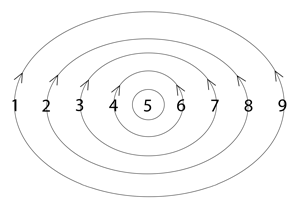identity
3-4-7
Conventional Understanding
We’re taught to think of identity as a collection of labels – our job title, relationship status, achievements, and personality traits. This creates an exhausting game of keeping up appearances. We end up defending “who I am” like territory, becoming more rigid and less alive in the process.
Resonant Understanding
Word Cosmology reveals “identity” carrying a 3-4-7 resonance pattern, sharing this numeric signature with “organizing principles” and “process of individuating.” Identity functions more like a doorway than a room. It’s not a collection of things you own or traits you possess, but the organizing threshold where experience takes shape and becomes recognizable.
Think of how water creates different patterns depending on what it flows through – a circular opening creates spiral patterns, while a square opening creates different flows. The opening doesn’t create the water but shapes how it appears. Similarly, identity doesn’t create your experience but provides the pattern through which you recognize it.
Expressions Spectrum Analysis
In balanced expression, this resonance pattern appears as “I am being conscious” and “ability to comprehend.” You recognize yourself without getting stuck in rigid definitions. There’s a natural “surrender to ease” and “spirit awareness” – you’re defined but not confined.
When over-modulated, expressions include “accomplishment” and “control.” Life becomes about “proof” and “taking charge.” You might find yourself obsessed with “romanticizing” your story or “complicating” simple situations. The doorway becomes a fortress.
Under-modulated expressions such as “fear of living” and “empty” demonstrate what appears when identity lacks sufficient definition. Without enough structure, you might experience “I can’t breathe” or “what’s the point?” The doorway becomes too unstable to allow meaning to flow through.
Russell’s Cosmogony Connection
Walter Russell describes formed bodies as ‘pressure-conditioned motion’ that simulate ideas rather than being the ideas themselves. Similarly, identity corresponds with the organizing principle through which cognitive recognition appears rather than being what it recognizes. Russell emphasized understanding through organizing principles rather than accumulation of facts – just as identity functions not as accumulated traits but as the organizing doorway through which recognition occurs.
Practical Implications
Instead of building a more impressive identity filled with achievements, focus on creating a clearer doorway through which life can flow without distortion.
When facing challenges, rather than strengthening your identity fortress, ensure the doorway remains unobstructed. Practice “surrender to loving life” and “return to balance” – not abandoning all definition, but holding it lightly.
This explains why identity crises often accompany major life transitions – we’ve mistaken the doorway for the room itself. By recognizing identity as the organizing threshold rather than a collection of attributes, we can maintain clarity without rigidity, allowing both distinctive expression and authentic presence.
The question shifts from “Who am I?” to “How clearly am I allowing life to organize and express through me?”
Related Words:
No results found.


